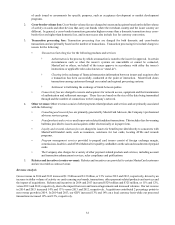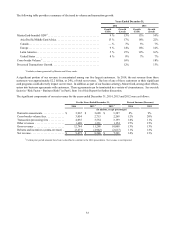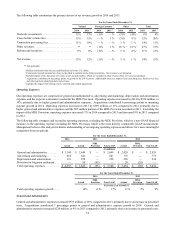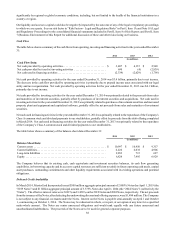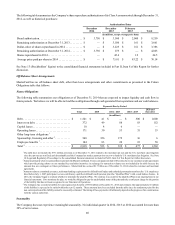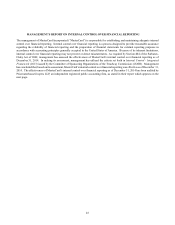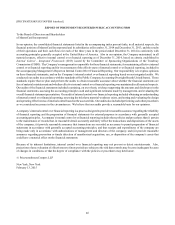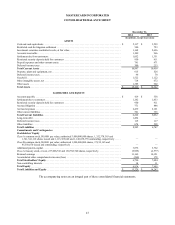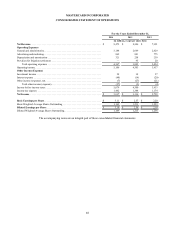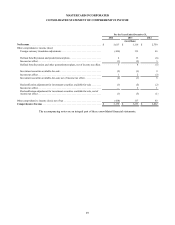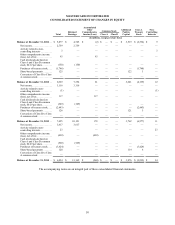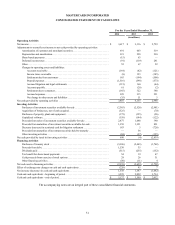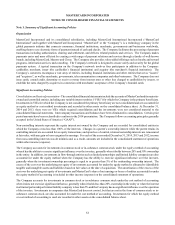MasterCard 2014 Annual Report Download - page 44
Download and view the complete annual report
Please find page 44 of the 2014 MasterCard annual report below. You can navigate through the pages in the report by either clicking on the pages listed below, or by using the keyword search tool below to find specific information within the annual report.42
if so, how current law impacts the amount reflected within these financial statements. If upon examination, we realize a tax benefit
which is not fully sustained or is more favorably sustained, this would decrease or increase earnings in the period. In certain
situations, the Company will have offsetting tax credits or taxes in other jurisdictions.
We do not record U.S. income tax expense for foreign earnings which we intend to reinvest indefinitely to expand our international
operations. We consider business plans, planning opportunities, and expected future outcomes in assessing the needs for future
expansion and support of our international operations. If our business plans change or our future outcomes differ from our
expectations, U.S. income tax expense and our effective tax rate could increase or decrease in that period.
Valuation of Assets
The valuation of assets acquired in a business combination and asset impairment reviews require the use of significant estimates
and assumptions. The acquisition method of accounting for business combinations requires the Company to estimate the fair
value of assets acquired, liabilities assumed, and any non-controlling interest in the acquiree to properly allocate purchase price
consideration between assets that are depreciated and amortized from goodwill. Impairment testing for assets, other than goodwill
and indefinite-lived intangible assets, requires the allocation of cash flows to those assets or group of assets and if required, an
estimate of fair value for the assets or group of assets. The Company’s estimates are based upon assumptions believed to be
reasonable, but which are inherently uncertain and unpredictable. These valuations require the use of management’s assumptions,
which would not reflect unanticipated events and circumstances that may occur.
We evaluate goodwill and indefinite-lived intangible assets for impairment on an annual basis or sooner if indicators of impairment
exist. Goodwill is tested for impairment at the reporting unit level. The impairment evaluation utilizes a quantitative assessment
using a two-step impairment test. The first step is to compare the reporting unit’s carrying value, including goodwill, to the fair
value. The Company uses a market approach for estimating the fair value of its reporting unit. If the fair value exceeds the carrying
value, then no potential impairment is considered to exist. If the carrying value exceeds the fair value, the second step is performed
to determine if the implied fair value of the reporting unit’s goodwill exceeds the carrying value of the reporting unit. An impairment
charge would be recorded if the carrying value exceeds the implied fair value. The impairment test for indefinite-lived intangible
assets consists of a qualitative assessment to evaluate all relevant events and circumstances that could affect the significant inputs
used to determine the fair value of indefinite-lived intangible assets. In performing the qualitative assessment, we consider relevant
events and conditions, including but not limited to, macroeconomic trends, industry and market conditions, overall financial
performance, cost factors, company-specific events, and legal and regulatory factors. If the qualitative assessment indicates that
it is more likely than not that the fair value of the indefinite-lived intangible asset is less than their carrying amounts, the Company
must perform a quantitative impairment test.
Item 7A. Quantitative and Qualitative Disclosures About Market Risk
Market risk is the potential for economic losses to be incurred on market risk sensitive instruments arising from adverse changes
in market factors such as interest rates, foreign currency exchange rates and equity price risk. Our exposure to market risk from
changes in interest rates, foreign exchange rates and equity price risk is limited. Management establishes and oversees the
implementation of policies governing our funding, investments and use of derivative financial instruments. We monitor risk
exposures on an ongoing basis. The effect of a hypothetical 10% adverse change in foreign currency rates could result in a fair
value loss of approximately $74 million on our foreign currency derivative contracts outstanding at December 31, 2014 related
to the hedging program. A 100 basis point adverse change in interest rates would not have a material impact on the Company’s
financial assets or liabilities at December 31, 2014 and 2013. In addition, there was no material equity price risk at December 31,
2014 or 2013.
Foreign Exchange Risk
We enter into forward contracts to manage risk associated with anticipated receipts and disbursements which are either transacted
in a non-functional currency or valued based on a currency other than our functional currency. We also enter into foreign currency
derivative contracts to offset possible changes in value due to foreign exchange fluctuations of earnings, assets and liabilities
denominated in currencies other than the functional currency of the entity. The objective of these activities is to reduce our exposure
to transaction gains and losses resulting from fluctuations of foreign currencies against our functional and reporting currencies,
principally the U.S. dollar and euro. The terms of the forward contracts are generally less than 18 months.


